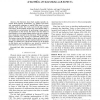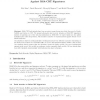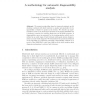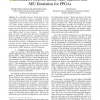FDTC
2011
Springer
13 years 5 months ago
2011
Springer
Abstract—The literature about fault analysis typically describes fault injection mechanisms, e.g. glitches and lasers, and cryptanalytic techniques to exploit faults based on som...
ETS
2011
IEEE
13 years 5 months ago
2011
IEEE
—The notion of Architectural Vulnerability Factor (AVF) has been extensively used by designers to evaluate various aspects of design robustness. While AVF is a very accurate way ...
CHES
2011
Springer
13 years 5 months ago
2011
Springer
RSA-CRT fault attacks have been an active research area since their discovery by Boneh, DeMillo and Lipton in 1997. We present alternative key-recovery attacks on RSA-CRT signature...
DSD
2009
IEEE
14 years 3 months ago
2009
IEEE
Several traditional VHDL fault injection mechanisms like mutants or saboteurs have been adapted to SystemC model descriptions. The main drawback of these approaches is the necessi...
FDTC
2010
Springer
14 years 3 months ago
2010
Springer
Fault injections constitute a major threat to the security of embedded systems. The errors in the cryptographic algorithms have been shown to be extremely dangerous, since powerful...
ICSOC
2010
Springer
14 years 4 months ago
2010
Springer
In this demo paper we present the prototype of our fault injection testbed generator. Our tool empowers engineers to generate emulated SOA environments and to program fault injecti...
ICFEM
2010
Springer
14 years 4 months ago
2010
Springer
We present an algorithm based on temporal-epistemic model checking combined with fault injection to analyse automatically the diagnosability of faults by agents in the system. We d...
TSE
1998
14 years 5 months ago
1998
An important step in the development of dependable systems is the validation of their fault tolerance properties. Fault injection has been widely used for this purpose, however wi...
CSREAESA
2009
14 years 6 months ago
2009
Two embedded processor based fault injection case studies are presented which are applicable to Field Programmable Gate Arrays (FPGAs) and FPGA cores in configurable System-on-Chip...
FTCS
1998
14 years 7 months ago
1998
The traditional use of formal methods has been for the veri cation of algorithms or protocols. Given the high cost and limitations in state space coverage provided by conventional...






